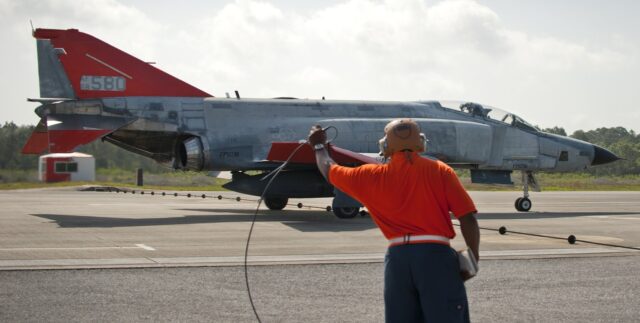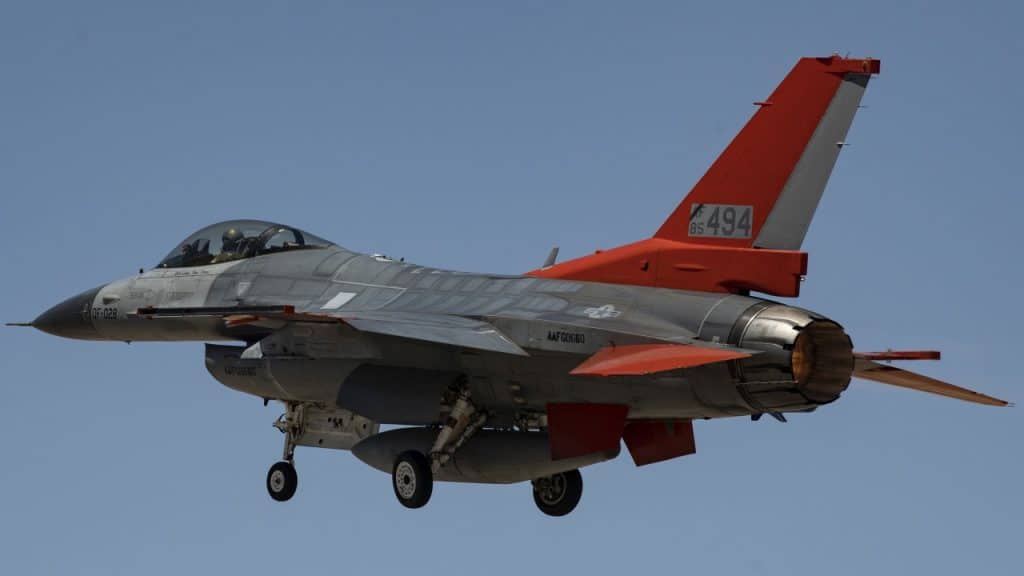The US Air Force officially handed over the last QF-16 Full Scale Aerial Target (FSAT) by Boeing on August 16. The machine was handed over to the personnel of the 82nd Aerial Targets Squadron of the 53rd Armament Assessment Squadron from Tyndall base in Florida. The FSAT can take off, maneuver, develop supersonic speed, and land with an empty cabin in remote control mode, but it can still fly the perfectly traditional F-16 if necessary – with a man in the seat.
Work to transform a manned fighter into an optional manned flying target has so far been carried out at the Cecil Airport plant in Jacksonville, Florida. Boeing’s participation in the program has now ended, but there will be more QF-16s. A second production line was set up at the AMARG landfill at the Davis-Monthan base in Arizona. Boeing worked on the QF-16 program for twelve years.
-ADVERTISEMENT-

The first machine to be converted (F-16C Block 30B, serial number 85-1570) was delivered to Jacksonville in April 2010. The flight of the prototype – which was then assigned the tactical number QF-001 – took place in May 2012. The machine then made a sixty-six-minute flight. During this flight, the not fully proven remote control system, however, secured the pilot. On November 19, 2012, the QF-16 (85-1569 / QF-005) landed for the first time at Tyndall. Flights in an unmanned configuration are defined with the abbreviation NULLO – Not Under Live Local Operator (not under the control of a live local operator).
On September 19, 2013, the first unmanned flight was carried out in Tyndall, during which the plane was controlled from the ground by two operators – US Air Force pilots. The machine soared twelve kilometers, developed a speed of Ma = 1.47 and performed several maneuvers (including a barrel and a half-loop), and the test was successful. A month later, Boeing was contracted to convert the first batch of thirteen flying targets, and less than a year later – for another twenty-three, and ten months later – for twenty-five more.
A Boeing QF-16 takes off from the 309th Aerospace Maintenance and Regeneration Group at Davis-Monthan #AirForce Base, #Arizona… https://t.co/PJWXoaiBmr pic.twitter.com/9fJb7Br34L
– DVIDSHub (@DVIDSHub) August 9, 2020
The first serial QF-16 (86-0233 / QF-007) was delivered to Tyndall in March 2015. In September 2016, it was announced that the new flying targets had reached initial operational readiness.
The QF-16, colloquially known as Zombie Vipers, finally took the place of other optionally manned flying targets – the QF-4 Phantom IIs in 2016. Each QF-16 has an airframe life of 300 hours. FSATs are made by modifying the old F-16 versions that have been withdrawn from service and preserved at the Davis-Monthan base.

QF-4 taxi to take off from Tyndall base on May 12, 2015. The machine was shot down shortly afterwards as part of the “Combat Archer” exercise. It was the last QF-4 to experience such a fate.
(US Air Force / Sara Vidoni)
The USAF wants to convert as many as 126 F-16A / C, but even with such a large number (almost three times more than the Polish Hawk fleet), every attempt cannot be ended with actual shooting. Therefore, most QF-16 flights do not end up destroying the flying target. Even if the scenario of the exercise assumes launching a missile, it usually lacks a warhead (a package of telemetry equipment is installed in its place) and the “destruction” of the QF-16 is verified on the basis of a calculation of whether the target would be electrocuted in an actual combat situation.
But if it has to be destroyed, it is destroyed. For example, the QF-005 was knocked down by the Sidewinder by the F-35C in June 2018, and the QF-001 by the AMRAAM with the F-15C in September 2017. Of course, this is usually what FSATs that end up with are used for.
In November last year, it was revealed that the QF-16 are intensively participating in the development of the new-generation AIM-260 Joint Advanced Tactical Missile air-to-air missile. During the previous year, the Zombie Vipers made about thirty flights under the AIM-260 program.
See also: Chinese nuclear-powered torpedo – journalistic duck or not?
US Air Force / Tech. Sgt. Perry Aston

